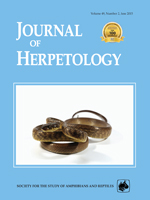We quantified the abundance of pelagic sea snakes, Hydrophis (= Pelamis) platurus, while following slicks that formed drift lines during 3 yr of research in the Golfo de Papagayo, Costa Rica. The number of snakes we observed floating on slicks varied greatly and ranged from 0 to 1,029 per hour. The largest number we observed was highly unusual in recent experience but comparable to earlier reports of sea snake aggregations in the historical literature. Snakes were more abundant on slicks with flotsam during early morning hours on clear, calm days. However, ‘decisions' of sea snakes to spend time floating on slicks are also influenced by other factors that are not known or are poorly understood. Neither temperature nor salinity influenced the number of snakes we observed within the range of the parameters we encountered. We observed only a single snake during 13 days of searching during which there were red tide conditions with cold and turbid water disturbed almost daily by high winds. We also counted floating snakes at the inner basin of the Golfo Dulce in southern Costa Rica, where the population of H. platurus contains almost exclusively xanthic (all-yellow) individuals. These snakes are behaviorally different and are most-commonly observed while floating at night, without any strong association with slicks. Mean counts of these xanthic snakes suggest the abundance of pelagic sea snakes is essentially similar in Golfo Dulce (21.4 ± 4.4 snakes/h) and Golfo de Papagayo (19.3 ± 4.4 snakes/h, neglecting the single, unusually high count of 1,029 snakes/h).
How to translate text using browser tools
1 June 2015
On the Abundance of a Pelagic Sea Snake
Harvey B. Lillywhite,
Coleman M. Sheehy III,
François Brischoux,
Joseph B. Pfaller
ACCESS THE FULL ARTICLE

Journal of Herpetology
Vol. 49 • No. 2
June 2015
Vol. 49 • No. 2
June 2015




